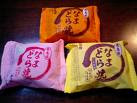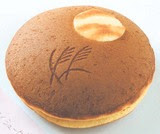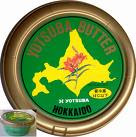[ . BACK to WORLDKIGO TOP . ]::::::::::::::::::::::::::::::::::::::::::::::::::::::::::::::::::::::::::::::::::::::::::::::::::::
FEBRUARY ... nigatsu 二月
:::::::::::::::::::::::::::::::::::::::::::::::::::::::::::::::::::::::::::::::::::::::::::::::::::
.............. February 1, 2010Lamb Raised on Wine Lees on Sale in JapanFujisan Farm, located in Fujiyoshida City in Yamanashi Prefecture, Japan, started selling lamb labeled "Fujisan Wine Lamb" in January 2010. The animals are raised on feed containing wine lees and bean curd refuse.
The feed was developed at the Yamanashi Prefecture Livestock Experiment Station utilizing wine lees and bean curd refuse, which are usually disposed of as industrial waste. The same type of feed has been used for beef cattle, but this is the first time it has been used for sheep.
http://www.japanfs.org/en/pages/029682.html
ぶどう粕・おから・酒粕・とうもろこし・麦等の粕類混合資料で、自然豊かな山梨で育てた特産牛
budookasu ブドウかす wine lees
Fujisan wain ramu 富士山ワインラム Fujisan wine lamb
牧場初の羊肉ブランド
:::::::::::::::::::::::::::::::::::::::::::::::::::::::::::::::::::::::::::::::::::::::::::::::::::
:::::::::::::::::::::::::::::::::::::::::::::::::::::::::::::::::::::::::::::::::::::::::::::::::::
.............. February 3, 2009Ehomaki Sushi Roll (ehoomaki) for Setsubun
World Pastry Cup 2009 Yokohama クープ・デュ・モンド・ドゥ・ラ・パティスリー
Coupe du Monde de la Pâtisserie
:::::::::::::::::::::::::::::::::::::::::::::::::::::::::::::::::::::::::::::::::::::::::::::::::::
.............. February 9, 2009Day of Meat (niku no hi) NI KUnigatsu kunichi................................
February 8/9 Tengu Matsuri in Sakaide
tengujiru 天狗(てんぐ)汁 soup with 10 vegetable ingredients
TEN is from the english number 10, GU is from the Japanese meaning ingredients.
TENGU is also the long-nosed goblin of Japanese legend.
This kindof soup was given to the people at 国分寺で健康まつり in Shikoku, for example.
and to 2500 people at the Tengu Festival in Sakaide, Shikoku. 坂出天狗まつり(坂出市)
十種類の野菜を使った てんぐ汁
10種類の具が入った てんぐ汁
Tengu and Daruma 天狗とだるま天狗汁 まだ やられたか日本語に
tengu jiru ...again I am surprizedby the JapaneseGabi Greve
:::::::::::::::::::::::::::::::::::::::::::::::::::::::::::::::::::::::::::::::::::::::::::::::::::
.............. February 10, 2009 Food Fair in Tokyo
Food Fair in TokyoA three-day gastronomic extravaganza kicked off Monday in Tokyo, bringing in top chefs from around the world to stimulate the culinary industry and promote Japanese food culture.
"Tokyo Taste — the World Summit of Gastronomy 2009" is the first culinary event of its kind in Japan, organizers said, featuring programs from onstage cooking performances and workshops to exhibition booths for food products.
The industry is hoping this kind of summit will help Japanese cuisine gain further popularity, given that Tokyo has recently been acclaimed by some as the world's capital of good food, not to mention Michelin awarding more to restaurants here than in any other city.
"Japanese food is the most closely watched in the world," former Prime Minister Junichiro Koizumi said at an opening ceremony.
source : Japan Times More reference :::::::::::::::::::::::::::::::::::::::::::::::::::::::::::::::::::::::::::::::::::::::::::::::::::
.............. February 11, 2009Oita's shiitake farmers benefit as demand for cheap imports dropsOita Prefecture's shiitake farmers, who have struggled for years amid a flood of low-priced imports from China, are enjoying an unexpected change in fortunes as demand for domestically grown food surges.
The prefecture, which boasts of being the largest producer of dried shiitake in Japan, is benefiting from consumer concerns about the safety of food products from abroad, particularly China.
"Ordinary consumers are opting for domestic shiitake and steering clear of Chinese products due to a series of scandals involving Chinese-made food products last year," said Eiji Kugumiya, who advises a farmers' cooperative, referring to incidents in which Japanese people fell ill after eating tainted imports.
Mushroom growers in the prefecture were given welcome news by Oita's shiitake agricultural cooperative in December, when it was confirmed that the average bidding price in 2008 reached ¥4,859 per kg.
Although the price was lower than the ¥6,812 recorded in the heady days of 1983, it was a considerable improvement on the prices of around ¥2,000 recorded in the second half of the 1980s as imports of Chinese mushrooms surged.
Oita Prefecture accounted for around a quarter of the 16,000 tons of shiitake mushrooms produced in the country when output peaked in 1984.
In 2007, the latest year for which data are available, domestic production had fallen to about 3,500 tons, of which Oita contributed about 1,300 tons.
Imports of Chinese mushrooms exceeded 9,000 tons in 1997 but dropped to around 7,000 tons in 2007. Most of the imports are supplied to businesses, according to Oita cooperative adviser Kugumiya.
The Oita shiitake co-op has about 4,000 members, a decline of about 2,600 from 25 years ago, and the average age of members is 68.
MORE
source : www/japantimes.co.jp :::::::::::::::::::::::::::::::::::::::::::::::::::::::::::::::::::::::::::::::::::::::::::::::::::
.............. February 13, 2009Philip Harper is a Briton. He is the first foreign-born person to earn the title of toji (brewmaster) in Japan. Harper is at the moment the master brewer at the Tamagawa brewery in Kumihama, Japan.
He is author of "The Insider's Guide to Sake".
Reference :::::::::::::::::::::::::::::::::::::::::::::::::::::::::::::::::::::::::::::::::::::::::::::::::::
.............. February 19, 2009quote Japan TimesTokyo Taste summit provides food for thoughtTop chefs stimulated by fresh ingredients, health consciousness and rich culture
By MELINDA JOE
These days, the mere mention of Tokyo is enough to make gourmands drool. After garnering a staggering
227 Michelin stars this year, the city became the focus of the culinary world. So for several internationally renowned chefs who look to Japan for inspiration, traveling here last week to participate in the
Tokyo Taste World Gastronomy Summit must have felt like a pilgrimage to Mecca.
The event at the Tokyo International Forum, which aimed to foster intercultural communication through the language of cuisine, brought foreign superstars such as Ferran Adria of Spain's El Bulli , Joel Robuchon of Paris' L'Atelier de Joel Robuchon and Pierre Gagnaire of Paris' Pierre Gagnaire restaurant together with local celebrities including Seiji Yamamoto of Roppongi's Ryugin and Yoshihiro Narisawa of Aoyama's Les Creations de Narisawa, as well as chefs representing the next generation of the avant garde. Over the course of three days, the chefs wowed audiences with displays of kitchen wizardry, producing fantastic creations using Japanese ingredients.
With Japanese restaurants numbering 25,000 worldwide and countless others serving dishes influenced by Japan, food translates into valuable cultural capital for the country. For many, a bite of sushi or a sip of miso soup is their first contact with Japanese culture.
Adria, often credited with popularizing molecular gastronomy, a deconstructivist interpretation of nouvelle cuisine that relies heavily on science and cutting-edge technology, cites his first visit to Japan as a life-changing experience. Referring to Japanese cuisine as "a mysterious world of complexity," he noted that Japanese culture has been slow to make inroads into Europe.
Nobuyuki Matsuhisa of the world-famous chain of Nobu restaurants described acquainting foreign diners with Japanese foods such as sashimi as a delicate process that requires a great deal of modification. Now that the foundation has been laid, he hopes to introduce more traditional Japanese foods and techniques abroad.
Beyond the discovery of new ingredients such as yuzu (citrus fruit) and sansho (Japanese pepper), chefs find inspiration in Japanese attitudes toward food:
the appreciation of seasonal offerings, emphasis on quality and pride in local produce.
This "reverence for ingredients" and established practices led Britain's foremost molecular gastronomist, Heston Blumenthal of The Fat Duck restaurant, to re-evaluate his own country's culinary history. His research has unearthed a treasure trove of recipes from the Victorian era that have fallen out of fashion, such as mock turtle soup, which uses organ meats to imitate the viscous texture of green turtle soup.
But despite a tradition of proper concern for food, evidence suggests that even the famously health-conscious Japanese aren't immune to the negative effects of modern life, which have taken a toll on eating habits. In response to a growing concern over lifestyle-induced health problems such as metabolic syndrome, in 2005 the government enacted the Basic Law on Shoku-iku (food and nutrition education), an initiative designed to increase awareness of Japanese food culture and encourage healthy habits through school- and community-based programs. Japan was the first country to take such measures.
Blumenthal maintains that it's important for chefs who have been fortunate enough not to have felt the effects of the recession, to be socially aware and active. He spoke passionately about the need to educate youth and discussed his book "Kitchen Chemistry" (2005), a resource for schools produced in partnership with Britain's Royal Society of Chemistry. Blumenthal's intention with the book is to explain practical chemistry in a light-hearted way with examples from the kitchen, such as the role of salt in cooking and the science involved in making ice cream.
Chefs Heston Blumenthal and Grant Achatz look to redefine dining Adria serves as director of the Alicia Foundation, which takes its name from a combination of the Spanish words for "food" and "science" — alimentacion and ciencia — a research center created by the Catalonian Parliament and the Bank of Manresa. The center focuses on exploring technology in kitchen science, preserving traditional foods and recipes, and advancing food safety, particularly in developing countries.
Adria believes that technology can be instrumental in promoting health and nutrition. During a demonstration with fellow Spaniard Andoni Luis Aduriz of the restaurant Mugaritz, Adria used liquid nitrogen to make a fat- and sucrose-free sorbet from fresh orange juice. He also discussed the positive health implications of vacuum-based cooking techniques such as sous-vide, which allows ingredients to be heated very slowly over a low heat, thus preserving their structural integrity and nutritional value.
As Kunio Tokuoka of Kyoto Kitcho pointed out, Japanese cooking techniques and ingredients have a role to play. Chef Tokuoka showed how glutamate-rich konbu dashi (seaweed soup stock) could be used to create simple, flavorful dishes that contain little fat and salt.
The presentations stimulated minds as well as appetites, and a tinge of excitement lingered in the air as Tokyo Taste came to a close. With events such as these being held in the city, eyes and palates should stay trained on Japan in the years to come.
The Japan Times (C) All rights reserved......................................
Don't call it molecular gastronomy — it's 'sensory design'Chefs
Heston Blumenthal and Grant Achatz look to redefine dining
By MELINDA JOE
A flaming sorbet served in a dish lined with red leather, a strip of clear film that releases the flavor of frankincense across the palate, a pressed wafer meant to smell of a newborn baby. I'm not talking about the sequel to "Willy Wonka & the Chocolate Factory," but chef Heston Blumenthal's presentation at last week's Tokyo Taste event.
Blumenthal — owner of The Fat Duck restaurant in Bray, England — dismisses the standard label of "molecular gastronomy" for his cooking and refers to his unique brand of dinner theater as "sensory design." His fanciful experiments stem from the belief that food should elicit an emotional response and his desire to introduce a sense of "wonderment" into a meal.
Kaiseki — a Japanese light "tasting-menu" meal — he says, is one of the few culinary forms to retain this element of drama and spectacle.
Blumenthal's eccentric creations are elaborate and require context — as well as instructions. His mock turtle soup, for example, is based on both a revised Victorian recipe and the Mad Hatter's tea party from "Alice in Wonderland." Diners are directed to dip bouillon that is molded in the shape of a pocket watch, wrapped in gold-leaf and attached to a tea-bag string, into a teacup of steaming-hot water before pouring the contents over a melange of pressed calf's head and a mock turtle "egg" adorned with tiny enoki mushrooms.
In a dish he calls Sound of the Sea, Blumenthal constructs a sandy seascape of fresh shellfish and pickled seaweed perched atop a curious mixture of tapioca maltodextrin (a food starch), crushed shirasu (baby anchovies) and powdered konbu (seaweed), finished with a spray of dashi (soup stock) foam. The platter is served alongside an iPod nestled in a conch shell, through whose speakers the sounds of waves and sea gulls can be heard. Blumenthal hit upon this idea after working with a behavioral psychologist who showed him how sound can affect a person's perception of taste.
One of the most rewarding aspects of his job, he says, is being able to collaborate with creative people in different disciplines. At the moment, he's working with a magician to find a way to ignite his signature flaming sorbet with a snap of the fingers. And next? Blumenthal says that he's interested in working with a scriptwriter to explore the narrative potential of a meal.
Tokyo Taste summit provides food for thought While Blumenthal aims to dazzle with whimsy,
Grant Achatz seeks to challenge with intellectual rigor. The 35-year-old owner and chef of Alinea restaurant in Chicago outlined design, food and service as the basic elements of the new wave of restaurants, where entertainment and the conjuring of emotions are among the primary objectives. Achatz and his team have become famous for their use of aroma "injections" to complement certain dishes. In one example, the chef introduced the scent of burning leaves to induce a nostalgic recollection of autumn.
Designer Martin Kastner, who manufactures cutlery and dishes expressly for Achatz's food, spoke with him about the importance of "challenging the vernacular of tableware" in order to expand the chef's ability to compose. His innovative designs establish new relationships between diners and the staff. One of his creations is a perfectly spherical bowl that can't be set down, requiring the dish to be handed directly from the server to the guest.
Service, Achatz asserts, can be utilized as an artistic tool. The guests could get directly involved in the creative process, for example, by choosing adjectives from a list that the kitchen staff would use to make a dish exhibiting those qualities. To break the rhythm of the service, diners could be led away from their tables midway through the meal to retrieve a morsel from a box set into the wall. The whole point is to "intimidate" people and cause them to question their concepts of food and the dining experience.
Chef Achatz concluded his demonstration by preparing a dish of thinly sliced wagyu beef topped with a vinegar reduction. As the room filled with the intoxicating aroma of rendered fat, we were reminded that — all intellectualizing aside — restaurants are still about food, and that, in the end, it has to taste good.
The Japan Times (C) All rights reserved*****************************Related wordsJANUARY ... ichigatsu 一月 DECEMBER ... juunigatsu 十二月 ***** WASHOKU ... SEASONAL DISHES SAIJIKI :::::::::::::::::::::::::::::::::::::::::::::::::::::::::::::::::::::::::::::::::::::::::::::::::::
WASHOKU
Regional Japanese Dishes WASHOKU
Roadside stations (michi no eki 道の駅) Highway Service Areas*****
WASHOKU
Ekiben 駅弁 Train Station Lunch Box TOP:::::::::::::::::::::::::::::::::::::::::::::::::::::::::::::::::::::::::::::::::::::::::::::::::::

 Excluding Hokkaido and the southern Japanese islands, tsuchinoko sightings have been reported all over Japan. As an actual tsuchinoko has never been formally cataloged by science, there is some speculation that other animals have been mistaken for the creature. Some believe the tsuchinoko legend to be based on encounters with snakes that recently swallowed a meal. The blue-tongued lizard, which became legal to own in Japan in the 1970s, also seems to be easily mistakable for a tsuchinoko; its only major difference in appearance is its four legs.
Excluding Hokkaido and the southern Japanese islands, tsuchinoko sightings have been reported all over Japan. As an actual tsuchinoko has never been formally cataloged by science, there is some speculation that other animals have been mistaken for the creature. Some believe the tsuchinoko legend to be based on encounters with snakes that recently swallowed a meal. The blue-tongued lizard, which became legal to own in Japan in the 1970s, also seems to be easily mistakable for a tsuchinoko; its only major difference in appearance is its four legs.






































